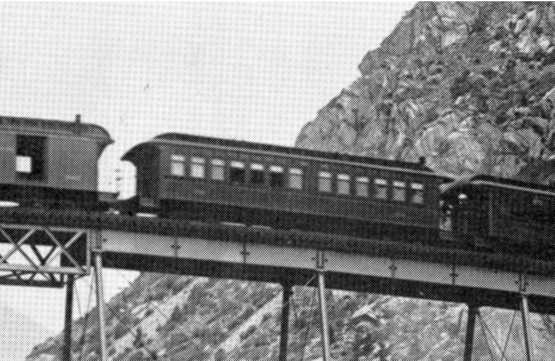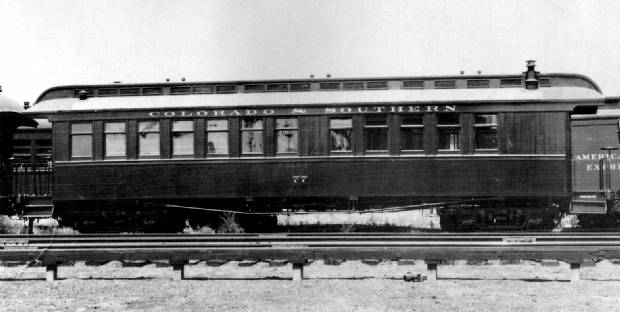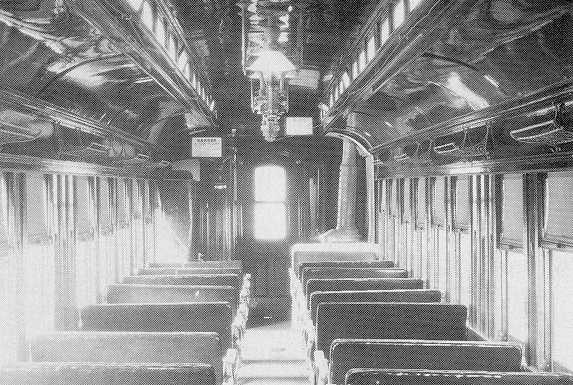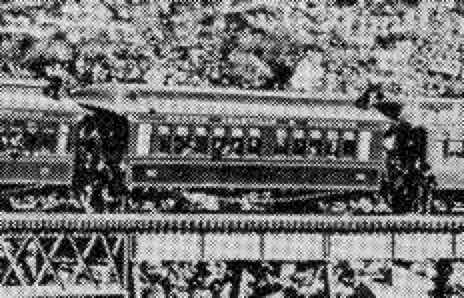Coach-Baggage (?) #4 - Halls Valley
|
|||||||||||||||||||||||||||||||||||||||||||||||||||||||||||||||||||||||||||||||||||||||||||||||||||||||
| “The combination passenger and express car is named ‘Halls Valley.’ The passenger cars are named ‘Geneva’ and ‘Leadville.’ ” |
Unfortunately, we have no photos of Halls Valley until it was more than 12 years old (see above). And if it was indeed rebuilt into a coach, that was done before its 7th year (1885), when the Union Pacific entered it on the roster as a coach and renumbered it in sequence with the two coaches that had come with it from the same builder.
One has to sincerely question whether Halls Valley was ever a combination coach-baggage car as we generally picture such a car, with a separate, windowless section devoted to express/baggage and having a separate door in the side of the car through which to load it. If it was, the DSP&P shops did a marvelous job of matching the original windows when they rebuilt the baggage end. Perhaps it was simply a two-section car, with one end devoted to express/baggage, without side-loading doors.
All we can know for sure is that Halls Valley was 4" to 6" shorter than its two Barney & Smith sisters (coach #3 and coach #5) and—at least in 1916 when the C&S passenger car diagram page for then C&S #77 was last updated—was 2" wider. And although shorter, it not only had the same number of windows (14 per side), but also had a distinctive panel between the two middle windows, meaning that the individual windows were not as wide.
Other than these features, there is nothing whatsoever about the car to suggest that it was ever anything other than a somewhat differently-configured coach, resembling in all other aspects its two sisters, coach #3 Geneva and coach #5 Leadville.
 |
(2) C&S #158 crossing the high bridge of the Georgetown Loop in 1901. (Did this car have some affinity for the Loop, for some reason?) Sorry for the blur, the car was moving! W.H. Jackson photo at Kindig-234 and Hauk-201. |
HISTORY
South Park car #4 was built by the Barney & Smith Manufacturing Company of Dayton Ohio. It was part of a three-car order {1} received 29 June 1878, shortly after the line was completed the 41 miles to Pine Grove. The other two cars were coaches #3 Geneva and #5 Leadville.
The Denver Daily Times of 29 June 1878 {9} said —
|
“They (the three Barney & Smith cars) are finely finished and will perfectly answer all requirements, both of beauty and utility. They came from Dayton, Ohio, over broad-gauge roads, broad-gauge trucks having been substituted for the narrow-gauge wheels, which were sent upon a flat car. |
Note that “beauty” was considered a requirement! Coaches of the day were quite ornate by today’s standards.
The new cars undoubtedly got their first work-out on the July 4 excursions that immediately followed.
Whether #4 was a true “combination” car or not, and how long it remained such is anyone’s guess—but it obviously wasn’t that longer than seven years. Besides knowing when it was rebuilt, it would also be interesting to know why, because the trend of car rebuilding on the South Park and its successors would always be in the other direction: from coach to combination.
(Some have suggested it might have been the next year, when coach-baggage #6 was acquired, but that doesn’t make sense when you realize (1) what is involved in changing the trusswork inside the walls of one kind of a car to those of another, and (2) that coach-baggage #6 itself appears to have been a coach converted to a coach-baggage when assembled by the South Park shops.)
In 1885, when the Union Pacific renumbered
everything, then-coach #4 was renumbered #64, a number it kept under the Denver,
Leadville and Gunnison. It was probably rebuilt at least once during this time
due to wear-and-tear, and the windows adjacent to the stoves at each end were
filled in. When the DL&G was merged into the Colorado & Southern in 1899, South
Park #4, now DL&G #64, was renumbered C&S #158, in sequence with its Barney &
Smith sisters, though not in the same order. Our guess is that the C&S—a great
deal better organized than the DSP&P— simply wanted to group the two similar
cars together.
| Name | DSP# | UP# | C&S# | C&S# |
| Geneva | 3 | 63 | 160 | 56 |
| Halls Valley | 4 | 64 | 158 | 77 |
| Leadville | 5 | 65 | 159 | 57 |
At the 1906 renumbering, C&S #158 became coach #77, completely out of sequence with its two Barney & Smith sisters. For some reason, the former Halls Valley—now C&S #158—was separated from its siblings, and therein lies “the rest of the story.”
 |
| (3) C&S #77 at Denver in 1936. Note two windows at the right end are now gone. Probably because the Spear Heater was larger than the normal stove. Photo at Poole-203. |
The DSP&P seems to have assigned numbers on a purely chronological basis, as if their roster were a pre-numbered list with each new car receiving the next number on the list. Since the three Barney & Smith cars were reportedly received at the same time, our guess would be that Halls Valley just happened to have been the 2nd of the three entered on the list, for whatever reason. Perhaps it was simply coupled between the other two when they arrived.
The Union Pacific was more systematic in its numbering (see the DSP&P Fleet Information page), but since all three cars were of the same type, from the same railroad, and by the same builder, they were renumbered together and in their original sequence.
When the C&S took possession of the three Barney & Smith cars, it switched the number sequence slightly, probably to group the two more-similar cars (#159, former Leadville, and #160, former Geneva) together. But when it renumbered the cars in 1906, it apparently saw something quite different in #158, former Halls Valley, for it numbered it way out of sequence from its sisters. Consider the following table showing the 1906 renumbering of coaches:
| Table Line |
Old # | New # | Qty | Length Over Endsills |
Source | Age | Built | Builder |
| 1. | 141-161 | 50-62 | 13 | 35' to 43' | Mixed | 20+ | 1886 | Various |
| 2. | 168-171 | 70-73 | 4 | 40' | UPD&G | 10 | 1896 | St. Charles |
| 3. | 172-174 | 74-76 | 3 | 40' | C&S | 6 | 1900 | AC&F |
| 4. | 158 | 77 | 1 | 40' | DL&G | 33 | 1873 | B&S |
| 5. | 162-167 | 78-83 | 6 | 42' | DL&G | 20 | 1880* | Pullman |
|
*
Most sources say 1886, but see the DSP&P
Fleet Information page and the Alternative Dates page for reasons we disagree. |
||||||||
In 1906, the C&S had 20 coaches that were all 20 years old or more. These bore numbers between #141 and #167 (lines 1 + 4 + 5 in table). With a few exceptions, these were renumbered in a block beginning at #50, with the numbers sequenced from the shortest car to the longest. The exceptions were seven coaches that had come from the Denver Leadville and Gunnison (lines 4 + 5). Six of these seven coaches were 26-year-old cars built by Pullman, and the other was 33-year-old #158.
These “exceptions” were grouped with seven other cars, all 10 years old or less, and renumbered in a separate block beginning at #70, with the numbers apparently sequenced by prior ownership (lines 2-5 in table). What set these 14 cars apart from the other coaches?
After giving it a great deal of thought and analysis, we’ve come to the conclusion that this group of cars represented the railroad’s best. Whether they were considered “first class” or not, we cannot say, but they certainly were that. According to the C&S car diagrams, the seven newer cars all had stoves, but the seven “old” South Park cars all had either Baker, Searle or Spear heating systems: all considered superior to common stoves. The Pullman cars had been built with Baker or Searle heaters, and coach #158 (now #77) had been equipped with a Spear Anti-Clinker Heater at some point along the line.
 |
(4) Interior of C&S #77 showing Spear Heater at far end. (Click pic for enlargement.) Photo at Poole-197. |
